
Seamanship is the art, knowledge and competence of operating a ship, boat or other craft on water. The Oxford Dictionary states that seamanship is "The skill, techniques, or practice of handling a ship or boat at sea."

A shipwreck is the wreckage of a ship that is located either beached on land or sunken to the bottom of a body of water. Shipwrecking may be intentional or unintentional. There were approximately three million shipwrecks worldwide as of January 1999, according to Angela Croome, a science writer and author who specialized in the history of underwater archaeology.

RRS Discovery is a barque-rigged auxiliary steamship built in Dundee, Scotland for Antarctic research. Launched in 1901, she was the last traditional wooden three-masted ship to be built in the United Kingdom. Her first mission was the British National Antarctic Expedition, carrying Robert Falcon Scott and Ernest Shackleton on their first, and highly successful, journey to the Antarctic, known as the Discovery Expedition.

In transportation, freight refers to goods conveyed by land, water or air, while cargo refers specifically to freight when conveyed via water or air. In economics, freight refers to goods transported at a freight rate for commercial gain. The term cargo is also used in case of goods in the cold-chain, because the perishable inventory is always in transit towards a final end-use, even when it is held in cold storage or other similar climate-controlled facilities, including warehouses.
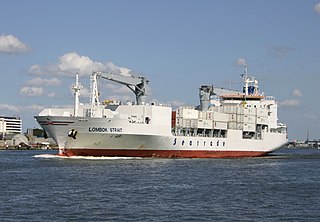
A reefer ship is a refrigerated cargo ship typically used to transport perishable cargo, which require temperature-controlled handling, such as fruits, meat, vegetables, dairy products, and similar items.
This glossary of nautical terms is an alphabetical listing of terms and expressions connected with ships, shipping, seamanship and navigation on water. Some remain current, while many date from the 17th to 19th centuries. The word nautical derives from the Latin nauticus, from Greek nautikos, from nautēs: "sailor", from naus: "ship".
![<span class="mw-page-title-main">K Line</span> Former Japanese shipping company, now [[Ocean Network Express]]](https://upload.wikimedia.org/wikipedia/commons/b/bf/K-stack.jpg)
Kawasaki Kisen Kaisha, Ltd. is a Japanese transportation company. It owns a fleet that includes dry cargo ships, container ships, liquefied natural gas carriers, Ro-Ro ships, tankers, and container terminals. It used to be the fourteenth largest container transportation and shipping company in the world, before becoming part of Ocean Network Express in 2017.

A bulk carrier or bulker is a merchant ship specially designed to transport unpackaged bulk cargo—such as grain, coal, ore, steel coils, and cement—in its cargo holds. Since the first specialized bulk carrier was built in 1852, economic forces have led to increased size and sophistication of these ships. Today's bulk carriers are specially designed to maximize capacity, safety, efficiency, and durability.
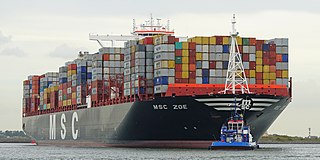
Mediterranean Shipping Company S.A, branded as MSC is an international shipping line founded by Gianluigi Aponte in Italy in 1970. The company is owned by the Aponte family with its headquarters in Switzerland since 1978. It is the world's largest container shipping company by both fleet size and cargo capacity, controlling about 19.7 percent of the global container ship fleet.
Scantling is a measurement of prescribed size, dimensions, or cross sectional areas.

A ballast tank is a compartment within a boat, ship or other floating structure that holds water, which is used as ballast to provide hydrostatic stability for a vessel, to reduce or control buoyancy, as in a submarine, to correct trim or list, to provide a more even load distribution along the hull to reduce structural hogging or sagging stresses, or to increase draft, as in a semi-submersible vessel or platform, or a SWATH, to improve seakeeping. Using water in a tank provides easier weight adjustment than the stone or iron ballast used in older vessels, and makes it easy for the crew to reduce a vessel's draft when it enters shallower water, by temporarily pumping out ballast. Airships use ballast tanks mainly to control buoyancy and correct trim.

USS Venango (AKA-82) was a Tolland-class attack cargo ship in service with the United States Navy from 1945 to 1946. She was sold into commercial service and was scrapped in 1971.
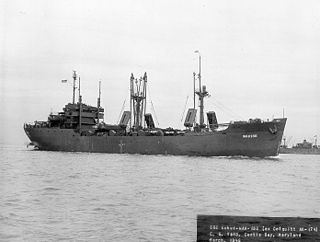
USCGC Kukui (WAK-186) was a Maritime Commission Type C1-M small cargo ship launched 21 January 1945, by Froemming Brothers, Milwaukee, Wisconsin, transferred to the Navy and commissioned and designated as USS Colquitt (AK-174) 22 September 1945. Two days later the ship was transferred to the Coast Guard for operation before being permanently transferred on 11 March 1946. Renamed Kukui and designated WAK-186 the ship was the largest in the Coast Guard with notable service installing, servicing and supplying the Loran-A and Loran-C electronic navigation chain stations in the Pacific until March 1972. The ship was transferred to the Philippines to serve as the Philippine Navy's supply ship BRP Mactan (TK90) until June 2001.
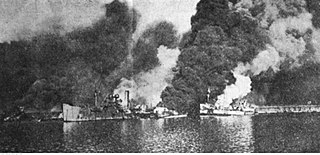
The air raid on Bari was an air attack by German bombers on Allied forces and shipping in Bari, Italy, on 2 December 1943, during World War II. 105 German Junkers Ju 88 bombers of Luftflotte 2 surprised the port's defenders and bombed shipping and personnel operating in support of the Allied Italian Campaign, sinking 27 cargo and transport ships, as well as a schooner, in Bari harbour.

In shipping, break-bulk, breakbulk, or break bulk cargo, also called general cargo, is goods that are stowed on board ships in individually counted units. Traditionally, the large numbers of items are recorded on distinct bills of lading that list them by different commodities. This is in contrast to cargo stowed in modern intermodal containers as well as bulk cargo, which goes directly, unpackaged and in large quantities, into a ship's hold(s), measured by volume or weight.
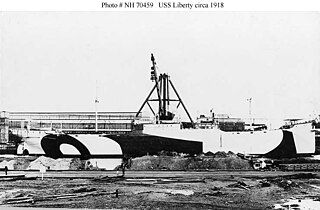
USAT Liberty was a United States Army cargo ship torpedoed by Japanese submarine I-66 in January 1942 and beached on the island of Bali, Indonesia. She had been built as a Design 1037 ship for the United States Shipping Board in World War I and had served in the United States Navy in that war as animal transport USS Liberty (ID-3461). She was also notable as the first ship constructed at Federal Shipbuilding, Kearny, New Jersey. In 1963 a volcanic eruption moved the ship off the beach, and Liberty's wreck is now a popular dive site.
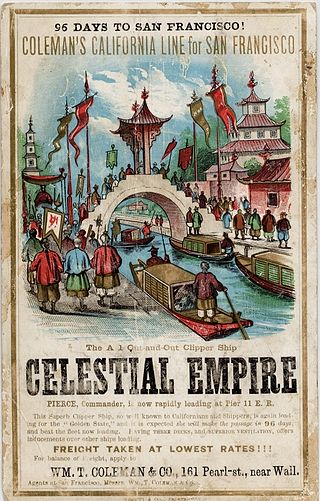
Celestial Empire was a long-lived medium clipper ship built in 1852 for the San Francisco trade. She met with a variety of mishaps characteristic for ships of her era. A second ship by this name set a legal precedent regarding damage done by sailing ships coming in to dock.

The SS U.S.S.R. Victory was the third Victory ship built during World War II under the Emergency Shipbuilding program. She was launched by the California Shipbuilding Company on February 26, 1944. The ship was completed and delivered to the wartime operator of all United States oceangoing shipping, the War Shipping Administration (WSA), on April 26, 1944. U.S.S.R. Victory, official number 245247, was assigned to Moore-McCormack Lines, Inc., under a standard WSA operating agreement at that time. That agreement continued until the ship's sale on March 7, 1947. The ship’s United States Maritime Commission designation was VC2-S-AP3, hull number 3 (V-3). U.S.S.R. Victory served in the Atlantic Ocean during World War II.
This glossary of nautical terms is an alphabetical listing of terms and expressions connected with ships, shipping, seamanship and navigation on water. Some remain current, while many date from the 17th to 19th centuries. The word nautical derives from the Latin nauticus, from Greek nautikos, from nautēs: "sailor", from naus: "ship".

USNS Victoria (T-AK-281) was a Norwalk-class fleet ballistic missile cargo ship, which was launched as a World War II commercial Victory cargo ship SS Ethiopia Victory under the Emergency Shipbuilding program. The Ethiopia Victory was acquired by the U.S. Navy in 1963.





![<span class="mw-page-title-main">K Line</span> Former Japanese shipping company, now [[Ocean Network Express]]](https://upload.wikimedia.org/wikipedia/commons/b/bf/K-stack.jpg)










